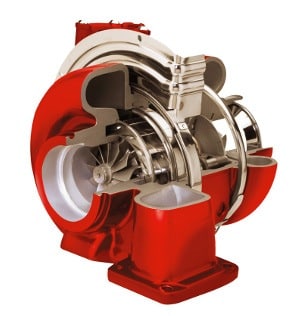How Variable Geometry Turbocharger for Marine Engines Works?
In order to draw the highest efficiency from marine engines, they must be run at the highest rated RPM. However, with several norms, traffic rules, fuel efficiency factor etc., marine engines cannot always be operated at high speed. As the RPM of the engine reduces, the air supply from the turbocharger also reduces, starving the combustion space of air and resulting in improper combustion and increased fuel consumption. To counter this problem, auxiliary blowers are fitted. These blowers come into action at particular low loads.
Variable Geometry Turbocharger or Variable Turbine Angle (VTA) Turbocharger is the solution for supplying sufficient scavenge air to marine engine’s cylinder at all load ranges. Let’s find out what is VTA and how does it works.
What is Variable Geometry Turbocharger or VTA?
A VGT or VTA is a turbocharger, wherein movable vanes are replaced for conventional fixed vanes, which can change angles to control the exhaust flow on the turbine blades. This helps the engine control to balance the volume of air with the fuel along the entire engine load range.
Working of VTA
The VGT or VTA consists of nozzle rings equipped with adjustable angle changing vanes.
Each vane is connected to control a ring using a lever, which reduces the thermal hysteresis and increases the positional accuracy.
The vane position or the angle is adjusted by the control ring connected to the electric positional motor via reduction gear.
The control system governs the action of the microprocessor controlled positional motor. The position or angle of vanes is thus altered after comparing the feedback signals of – air pressure after the blower, and exhaust gas temperature before and after the turbocharger.
Advantages of VTA
- Works on the entire load range of the engine
- Eliminates the need of auxiliary blower
- Reduces the fuel consumption
- Reduces exhaust smoke emission and hence air pollution
- Lower’s CO2 , Nox, and Sox emission
- Reduces soot and carbon deposits on combustion and exhaust space
- Reduces fouling of engine parts
- Improves efficiency of the engine
- Economical in operation
If you have any questions, please feel free to ask us in the comments below.
Do you have info to share with us ? Suggest a correction

About Author
An ardent sailor and a techie, Anish Wankhede has voyaged on a number of ships as a marine engineer officer. He loves multitasking, networking, and troubleshooting. He is the one behind the unique creativity and aesthetics at Marine Insight.
Latest Marine Technology Articles You Would Like:
- 10 Harmful Effects Of Impure Air On Ship’s Machinery
- 10 Important Things to Check While Starting Fuel Oil Purifier on Ships
- 10 Noteworthy LNG-Powered Vessels
- 10 Points for Efficient Turbocharger Operation On Ships
- 10 Practical Tips to Handle Engine Room Pumps
- 10 Precautions to Take Before Operating Controllable Pitch Propeller (CPP) on Ships
Subscribe To Our Newsletters
By subscribing, you agree to our Privacy Policy and may receive occasional deal communications; you can unsubscribe anytime.


















God informations…….
can you explain more about how the vanes are changing the angles..
Dear Krishant,
Please check the following video for better understanding- https://www.youtube.com/watch?v=CbdY1rymBJg
Respected sir thankyou very much for all the new informations and explanations.Sir i am a trainee marine engg and i have to present a ppt presentation of 15min…in a company for final selection.My topic is fuel saving devices for ship please guide.Thankyou in advance.
Dear Sumit: Some important fuel saving devices on ships are:
– Shaft generator
– Lambda control
– Exhaust gas boiler
– Hybrid turbocharger
– VGT
– Kite sail system
– Waste Heat Recovery System
– Speed Nozzle
Please use “Search box” in the side bar in https://www.marineinsight.com to get more details about these systems.
Thankyou very much sir….
Respected sir,
I have tried to include each and every topic u have suggested.I have included common rail and vit in addition.can u just hint me with the cross questions I have to counter..Thank you in advance.
how VTA lowers Nox emissions?
@ Pradeep.
Please check this press release by MAN diesel: https://dieselturbo.man.eu/
When VTA is integrated in two stage turbocharger (working on miller cycle) it reduces NOx upto 30%.
CAN ANY PLS POST ME THE ANSWER FOR THIS QUESTION.1.WHAT ARE THE FACTORS TO BE CONSIDERED FOR DESIGNING A TURBO CHARGER OF A MARINE ENGINE,2.WHAT IS THE FUNC TION OF THE SPCV (STAGNATION PRESSURE CONTROL VALVE) IN THE FUEL PUMP
Please ask your questions at https://forums.marineinsight.com for quicker replies..
Does this have any affect on turbocharger surging? Does it reduce surging or negate it completely?
Can you give a detailed explanation please?
We know it’s important for you to get a quick response for your question.
Thus, we created Marine Insight Forums >> https://forums.marineinsight.com
Kindly re-post your question at the forums, after a quick free sign-up and one our experts will reply to you at the earliest.
Register here now >> https://forums.marineinsight.com
Thanks a lot in advance.
Can you give a diagram for this. I want it for class2.